Estimation of the Mass Concentration of Volcanic Ash Using Ceilometers: Study of Fresh and Transported Plumes from La Palma Volcano
Abstract
1. Introduction
2. Sites and Instrumentation
2.1. Measurement Sites Description
2.2. AERONET Sunphotometers
2.3. Vaisala Ceilometers
3. Methodology
4. Results and Discussion
4.1. Characterization of La Palma Volcanic Eruption: Integrated Optical and Microphysical Properties
- It is expected that the AOD coarse mode decreases considerably during the days with a low frequency of volcanic particle emissions, impacting the volume concentration modes and modal radii directly. The analysis of the time series of the AOD for different sites over a region might address the conclusions about aerosol transport and the impact on radiative forcing. However, the impacts on global temperature (modifications of the thermal regime over extended areas) require that the magnitude of the event (i) reach extreme AOD values, (ii) pass high atmospheric levels to remain circulating the globe, and (iii) remains for long time periods.
- Considering that the volcanic activity has some synchronicity at the two sites (see Figure 3), if the top height of these events remained below 2 km, the AOD coarse mode might decrease considerably at RM.
- An indication of the aerosol transport can be obtained from the LP and RM stations since for days with high volcanic activity (intensity and height), more significant increases in the AOD coarse mode might be detected in one of the stations. Thus, conclusions about the ash transport either to the island’s center-north (RM station) or center-south (LP station) could be addressed. Nevertheless, to determine the direction of the volcanic plume transport, the magnitude and direction of local winds must be considered.
4.2. Spatio-Temporal Evolution of the Eruption from 19 September to 14 December 2021
4.3. Example Case: Volcanic Ash Detection on 24 and 25 September 2021 at Toulouse, France
4.3.1. Synoptic Analysis
4.3.2. Aerosol Radiative Properties
5. Conclusions
Author Contributions
Funding
Data Availability Statement
Acknowledgments
Conflicts of Interest
References
- Zhu, Y.; Toon, O.B.; Jensen, E.J.; Bardeen, C.G.; Mills, M.J.; Tolbert, M.A.; Yu, P.F.; Woods, S. Persisting volcanic ash particles impact stratospheric SO2 lifetime and aerosol optical properties. Nat. Commun. 2020, 11, 1723–2041. [Google Scholar] [CrossRef] [PubMed]
- Ayris, P.; Lee, A.; Wilson, K.; Kueppers, U.; Dingwell, D.; Delmelle, P. SO2 sequestration in large volcanic eruptions: High-temperature scavenging by tephra. Geochim. Cosmochim. Acta 2013, 110, 58–69. [Google Scholar] [CrossRef]
- Witt, V.; Ayris, P.M.; Damby, D.E.; Cimarelli, C.; Kueppers, U.; Dingwell, D.B.; Wörheide, G. Volcanic ash supports a diverse bacterial community in a marine mesocosm. Geobiology 2017, 15, 453–463. [Google Scholar] [CrossRef] [PubMed]
- Guffanti, M.; Ewert, J.W.; Gallina, G.M.; Bluth, G.J.; Swanson, G.L. Volcanic-ash hazard to aviation during the 2003–2004 eruptive activity of Anatahan volcano, Commonwealth of the Northern Mariana Islands. J. Volcanol. Geotherm. Res. 2005, 146, 241–255. [Google Scholar] [CrossRef]
- Weinzierl, B.; Sauer, D.; Minikin, A.; Reitebuch, O.; Dahlkötter, F.; Mayer, B.; Emde, C.; Tegen, I.; Gasteiger, J.; Petzold, A.; et al. On the visibility of airborne volcanic ash and mineral dust from the pilot’s perspective in flight. Phys. Chem. Earth Parts A/B/C 2012, 45–46, 87–102. [Google Scholar] [CrossRef]
- Song, W.; Hess, K.U.; Damby, D.E.; Wadsworth, F.B.; Lavallée, Y.; Cimarelli, C.; Dingwell, D.B. Fusion characteristics of volcanic ash relevant to aviation hazards. Geophys. Res. Lett. 2014, 41, 2326–2333. [Google Scholar] [CrossRef]
- Hirtl, M.; Arnold, D.; Baro, R.; Brenot, H.; Coltelli, M.; Eschbacher, K.; Hard-Stremayer, H.; Lipok, F.; Maurer, C.; Meinhard, D.; et al. A volcanic-hazard demonstration exercise to assess and mitigate the impacts of volcanic ash clouds on civil and military aviation. Nat. Hazards Earth Syst. Sci. 2020, 20, 1719–1739. [Google Scholar] [CrossRef]
- Ansmann, A.; Tesche, M.; Seifert, P.; Groß, S.; Freudenthaler, V.; Apituley, A.; Wilson, K.M.; Serikov, I.; Linné, H.; Heinold, B.; et al. Ash and fine-mode particle mass profiles from EARLINET-AERONET observations over central Europe after the eruptions of the Eyjafjallajökull volcano in 2010. J. Geophys. Res. Atmos. 2011, 116. [Google Scholar] [CrossRef]
- Boselli, A.; Scollo, S.; Leto, G.; Sanchez, R.Z.; Sannino, A.; Wang, X.; Coltelli, M.; Spinelli, N. First Volcanic Plume Measurements by an Elastic/Raman Lidar Close to the Etna Summit Craters. Front. Earth Sci. 2018, 6, 125. [Google Scholar] [CrossRef]
- Shimizu, A.; Iguchi, M.; Nakamichi, H. Seasonal Variations of Volcanic Ash and Aerosol Emissions around Sakurajima Detected by Two Lidars. Atmosphere 2021, 12, 326. [Google Scholar] [CrossRef]
- Mona, L.; Marenco, F. Chapter 9—Lidar Observations of Volcanic Particles. In Volcanic Ash; Mackie, S., Cashman, K., Ricketts, H., Rust, A., Watson, M., Eds.; Elsevier: Amsterdam, The Netherlands, 2016; pp. 161–173. [Google Scholar] [CrossRef]
- Dănilă, M.N.; Unga, F.; Cazacu, M.M.; Timofte, A.; Strat, M.; Dimitriu, D.G.; Gurlui, S. LIDAR Measurements Comparison of Two Volcanic Eruptions: Environmental Influences Upon The Romanian Territory. Ann. West Univ. Timis. Phys. 2015, 56, 68–75. [Google Scholar] [CrossRef][Green Version]
- Sicard, M.; Córdoba-Jabonero, C.; Barreto, A.; Welton, E.J.; Gil-Díaz, C.; Carvajal-Pérez, C.V.; Comerón, A.; García, O.; García, R.; López-Cayuela, M.-Á.; et al. Volcanic Eruption of Cumbre Vieja, La Palma, Spain: A First Insight to the Particulate Matter Injected in the Troposphere. Remote Sens. 2022, 14, 2470. [Google Scholar] [CrossRef]
- Pérez, N.M.; Hernández, P.A.; Melián, G.V.; Padrón, E.; Asensio-Ramos, M.; Barrancos, J.; Padilla, G.D.; Rodríguez, F.; D’Auria, L.; Amonte, C.; et al. The 2021 Cumbre Vieja eruption: An overview of the geochemical monitoring program. In Proceedings of the EGU General Assembly 2022, Vienna, Austria, 23–27 May 2022. [Google Scholar]
- D’Auria, L.; Koulakov, I.; Prudencio, J.; Cabrera-Pérez, I.; Ibáñez, J.M.; Barrancos, J.; García-Hernández, R.; Martínez-VanDorth, D.; Padilla, G.D.; Przeor, M.; et al. Tomographic imaging of the magmatic system feeding the 2021 Cumbre Vieja eruption (La Palma, Canary Islands). In Proceedings of the EGU General Assembly 2022, Vienna, Austria, 23–27 May 2022. [Google Scholar]
- Torres-González, P.A.; Luengo-Oroz, N.; Moure-García, Á.D.; Sáez-Gabarrón, L.; Villasante-Marcos, V.; López-Díaz, R.; Rodríguez-López, C.C.; D’Alessandro, W.; Pujol, L.; Grassa, F. Geochemical monitoring of the volcanic unrest and the eruption in La Palma island (Canary Islands, Spain): The 2017–2021 dataset and first results. In Proceedings of the EGU General Assembly 2022, Vienna, Austria, 23–27 May 2022. [Google Scholar]
- Milford, C.; Torres, C.; Vilches, J.; Suárez, D.; García, O.E.; Prats, N.; Barreto, A.; García, R.D.; Bustos, J.J.; Marrero, C.; et al. Air quality impacts of the 2021 volcanic eruption in La Palma (Canary Islands). 2022; In preparation. [Google Scholar]
- ACTRIS-Spain Coordinating Unprecedented Actions for the Cumbre Vieja volcanic Emergency. 2021. Available online: https://www.actris.eu/news-events/news/actris-spain-coordinating-unprecedented-actions-cumbre-vieja-volcanic-emergency (accessed on 22 September 2022).
- Carrillo, J.; Guerra, J.C.; Cuevas, E.; Barrancos, J. Characterization of the Marine Boundary Layer and the Trade-Wind Inversion over the Sub-tropical North Atlantic. Bound.-Layer Meteorol. 2016, 158, 311–330. [Google Scholar] [CrossRef]
- Barreto, A.; Cuevas, E.; García, R.D.; Carrillo, J.; Prospero, J.M.; Ilić, L.; Basart, S.; Berjón, A.J.; Marrero, C.L.; Hernández, Y.; et al. Long-term characterisation of the vertical structure of the Saharan Air Layer over the Canary Islands using lidar and radiosonde profiles: Implications for radiative and cloud processes over the subtropical Atlantic Ocean. Atmos. Chem. Phys. 2022, 22, 739–763. [Google Scholar] [CrossRef]
- Barreto, A.; García, R.D.; Guirado-Fuentes, C.; Cuevas, E.; Almansa, A.F.; Milford, C.; Toledano, C.; Expósito, F.J.; Díaz, J.P.; León-Luis, S.F. Aerosol characterization in the Subtropical Eastern North Atlantic region derived from long-term AERONET measurements. Atmos. Chem. Phys. Discuss. 2022, 2022, 1–28. [Google Scholar] [CrossRef]
- Holben, B.; Eck, T.; Slutsker, I.; Tanré, D.; Buis, J.; Setzer, A.; Vermote, E.; Reagan, J.; Kaufman, Y.; Nakajima, T.; et al. AERONET—A Federated Instrument Network and Data Archive for Aerosol Characterization. Remote Sens. Environ. 1998, 66, 1–16. [Google Scholar] [CrossRef]
- Giles, D.M.; Sinyuk, A.; Sorokin, M.G.; Schafer, J.S.; Smirnov, A.; Slutsker, I.; Eck, T.F.; Holben, B.N.; Lewis, J.R.; Campbell, J.R.; et al. Advancements in the Aerosol Robotic Network (AERONET) Version 3 database–automated near-real-time quality control algorithm with improved cloud screening for Sun photometer aerosol optical depth (AOD) measurements. Atmos. Meas. Tech. 2019, 12, 169–209. [Google Scholar] [CrossRef]
- Oneill, N.T.; Eck, T.F.; Smirnov, A.; Holben, B.N.; Thulasiraman, S. Spectral discrimination of coarse and fine mode optical depth. J. Geophys. Res. Atmos. 2003, 108, 4559. [Google Scholar] [CrossRef]
- Dubovik, O.; Sinyuk, A.; Lapyonok, T.; Holben, B.N.; Mishchenko, M.; Yang, P.; Eck, T.F.; Volten, H.; Muñoz, O.; Veihelmann, B.; et al. Application of spheroid models to account for aerosol particle nonsphericity in remote sensing of desert dust. J. Geophys. Res. Atmos. 2006, 111. [Google Scholar] [CrossRef]
- Sinyuk, A.; Holben, B.N.; Eck, T.F.; Giles, D.M.; Slutsker, I.; Korkin, S.; Schafer, J.S.; Smirnov, A.; Sorokin, M.; Lyapustin, A. The AERONET Version 3 aerosol retrieval algorithm, associated uncertainties and comparisons to Version 2. Atmos. Meas. Tech. 2020, 13, 3375–3411. [Google Scholar] [CrossRef]
- Bedoya-Velásquez, A.; Herreras-Giralda, M.; Román, R.; Wiegner, M.; Lefebvre, S.; Toledano, C.; Huet, T.; Ceolato, R. Ceilometer inversion method using water-vapor correction from co-located microwave radiometer for aerosol retrievals. Atmos. Res. 2021, 250, 105379. [Google Scholar] [CrossRef]
- Brooks, I.M. Finding Boundary Layer Top: Application of a Wavelet Covariance Transform to Lidar Backscatter Profiles. J. Atmos. Ocean. Technol. 2003, 20, 1092–1105. [Google Scholar] [CrossRef]
- Baars, H.; Ansmann, A.; Engelmann, R.; Althausen, D. Continuous monitoring of the boundary-layer top with lidar. Atmos. Chem. Phys. 2008, 8, 7281–7296. [Google Scholar] [CrossRef]
- Morille, Y.; Haeffelin, M.; Drobinski, P.; Pelon, J. STRAT: An Automated Algorithm to Retrieve the Vertical Structure of the Atmosphere from Single-Channel Lidar Data. J. Atmos. Ocean. Technol. 2007, 24, 761–775. [Google Scholar] [CrossRef]
- Ceolato, R.; Berg, M.J. Aerosol light extinction and backscattering: A review with a lidar perspective. J. Quant. Spectrosc. Radiat. Transf. 2021, 262, 107492. [Google Scholar] [CrossRef]
- Ceolato, R.; Bedoya-Velasquez, A.; Fossard, F.; Mouysset, V.; Paulien, L.; Lefebvre, S.; Mazzoleni, C.; Sorensen, C.; Berg, M.; Yon, J. Black carbon aerosol number and mass concentration measurements by picosecond short-range elastic backscatter lidar. Sci. Rep. 2022, 12, 761–775. [Google Scholar] [CrossRef]
- Zhang, Y.; Li, Z.; Liu, Z.; Wang, Y.; Qie, L.; Xie, Y.; Hou, W.; Leng, L. Retrieval of aerosol fine-mode fraction over China from satellite multiangle polarized observations: Validation and comparison. Atmos. Meas. Tech. 2021, 14, 1655–1672. [Google Scholar] [CrossRef]
- Theys, N.; De Smedt, I.; Yu, H.; Danckaert, T.; van Gent, J.; Hörmann, C.; Wagner, T.; Hedelt, P.; Bauer, H.; Romahn, F.; et al. Sulfur dioxide retrievals from TROPOMI onboard Sentinel-5 Precursor: Algorithm theoretical basis. Atmos. Meas. Tech. 2017, 10, 119–153. [Google Scholar] [CrossRef]
- Stein, A.F.; Draxler, R.R.; Rolph, G.D.; Stunder, B.J.B.; Cohen, M.D.; Ngan, F. NOAA’s HYSPLIT Atmospheric Transport and Dispersion Modeling System. Bull. Am. Meteorol. Soc. 2015, 96, 2059–2077. [Google Scholar] [CrossRef]
- Torres, B.; Dubovik, O.; Fuertes, D.; Schuster, G.; Cachorro, V.E.; Lapyonok, T.; Goloub, P.; Blarel, L.; Barreto, A.; Mallet, M.; et al. Advanced characterisation of aerosol size properties from measurements of spectral optical depth using the GRASP algorithm. Atmos. Meas. Tech. 2017, 10, 3743–3781. [Google Scholar] [CrossRef]
- Lekkas, E.; Meletlidis, S.; Kyriakopolous, K.; Manousaki, E.; Mavroulis, S.; Kostaki, E.; Michailidis, A.; Gogou, M.; Mavrouli, M.; Castro-Melgar, I.; et al. The 2021 Cumbre Vieja volcanoeruptionin La Palma (CanaryIslands). In Newsletter of Environmental, Disaster and Crises Management Strategies; 2021; Volume 26, Available online: https://edcm.edu.gr/en/newsletter/newsletter-26-2021-cumbre-vieja-volcano-eruption-in-la-palma-canary-islands (accessed on 3 November 2022).
- Derimian, Y.; Dubovik, O.; Tanre, D.; Goloub, P.; Lapyonok, T.; Mortier, A. Optical properties and radiative forcing of the Eyjafjallajökull volcanic ash layer observed over Lille, France, in 2010. J. Geophys. Res. Atmos. 2012, 117. [Google Scholar] [CrossRef]
- Prata, A.T.; Young, S.A.; Siems, S.T.; Manton, M.J. Lidar ratios of stratospheric volcanic ash and sulfate aerosols retrieved from CALIOP measurements. Atmos. Chem. Phys. 2017, 17, 8599–8618. [Google Scholar] [CrossRef]
- Kar, J.; Vaughan, M.; Tackett, J.L.; Omar, A.H.; Trepte, C.R.; Lucker, P. Constrained Lidar Ratios for Volcanic Ash and Sulfate Layers in the Stratosphere from CALIOP Version 4.10 data. In Proceedings of the AGU Fall Meeting Abstracts, Washington, DC, USA, 10–14 December 2018; Volume 2018, pp. A31P–3170. [Google Scholar]
- Mereu, L.; Scollo, S.; Boselli, A.; Leto, G.; Zanmar Sanchez, R.; Bonadonna, C.; Marzano, F.S. Dual-Wavelength Polarimetric Lidar Observations of the Volcanic Ash Cloud Produced during the 2016 Etna Eruption. Remote Sens. 2021, 13, 1728. [Google Scholar] [CrossRef]
- Müller, D.; Weinzierl, B.; Petzold, A.; Kandler, K.; Ansmann, A.; Müller, T.; Tesche, M.; Freudenthaler, V.; Esselborn, M.; Heese, B.; et al. Mineral dust observed with AERONET Sun photometer, Raman lidar, and in situ instruments during SAMUM 2006: Shape-independent particle properties. J. Geophys. Res. Atmos. 2010, 115. [Google Scholar] [CrossRef]
- Gasteiger, J.; Groß, S.; Freudenthaler, V.; Wiegner, M. Volcanic ash from Iceland over Munich: Mass concentration retrieved from ground-based remote sensing measurements. Atmos. Chem. Phys. 2011, 11, 2209–2223. [Google Scholar] [CrossRef]
- Schumann, U.; Weinzierl, B.; Reitebuch, O.; Schlager, H.; Minikin, A.; Forster, C.; Baumann, R.; Sailer, T.; Graf, K.; Mannstein, H.; et al. Airborne observations of the Eyjafjalla volcano ash cloud over Europe during air space closure in April and May 2010. Atmos. Chem. Phys. 2011, 11, 2245–2279. [Google Scholar] [CrossRef]
- WHO. WHO Global Air Quality Guidelines: Particulate Matter (PM2.5 and PM10), Ozone, Nitrogen Dioxide, Sulfur Dioxide and Carbon Monoxide; World Health Organization: Geneva, Switzerland, 2021; p. xxi, 273p. [Google Scholar]
- Copernicus Tracks Ongoing Emissions from La Palma Volcano Across Europe and the Caribbean. Technical Report, Copernicus Atmosphere Monitoring Service (CAMS). 2021. Available online: https://atmosphere.copernicus.eu/copernicus-tracks-ongoing-emissions-la-palma-volcano-across-europe-and-caribbean (accessed on 14 July 2022).
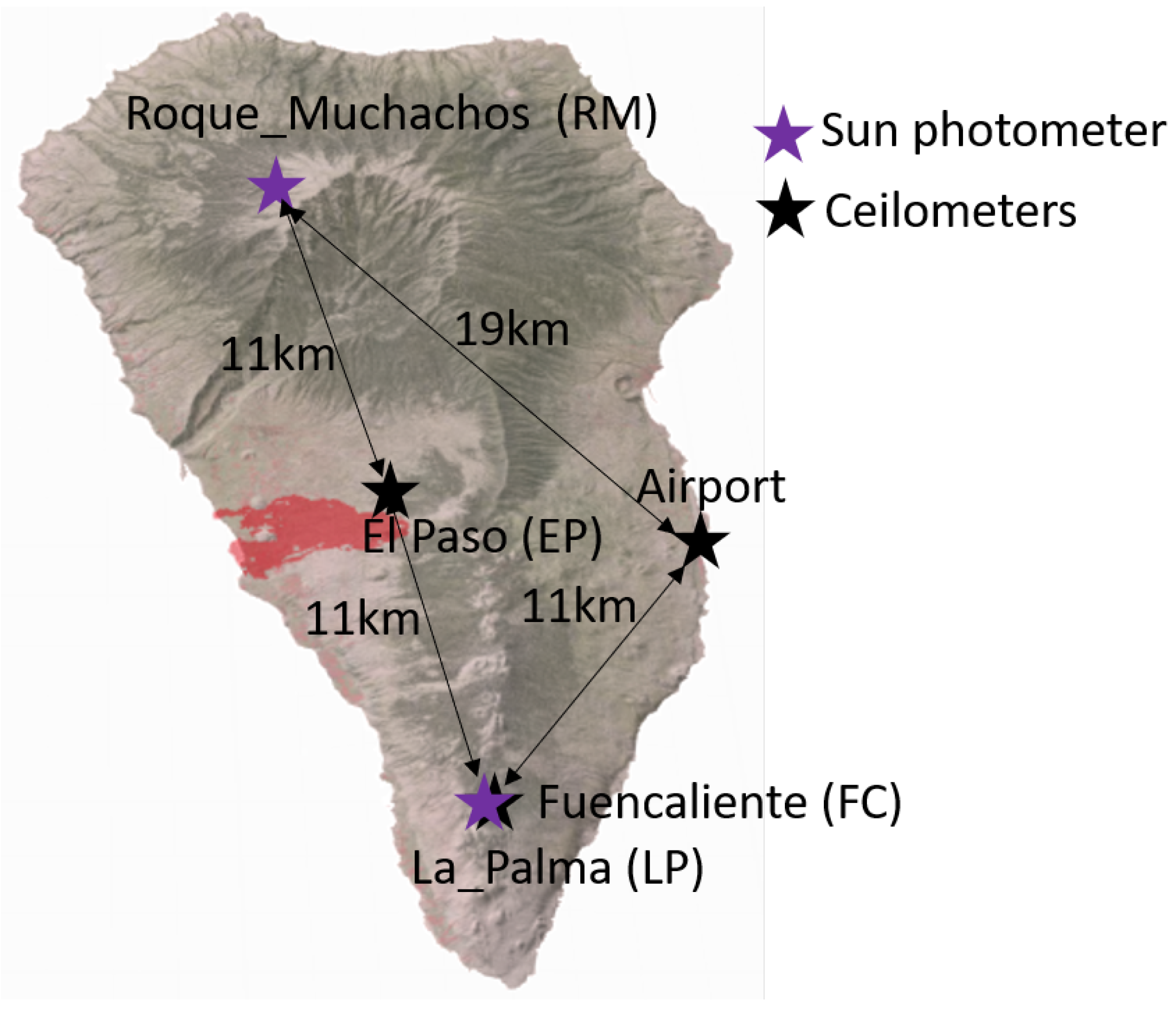

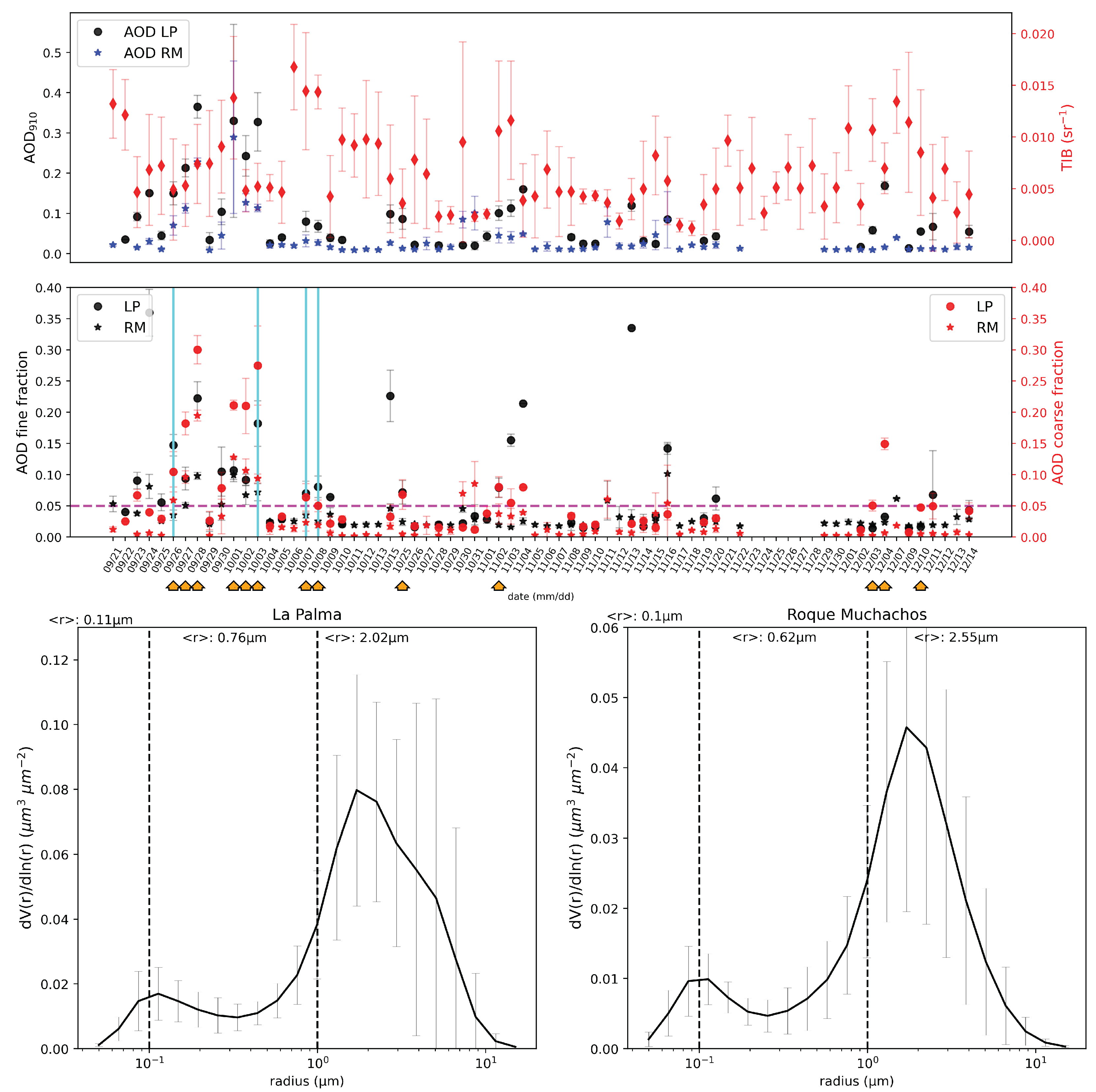
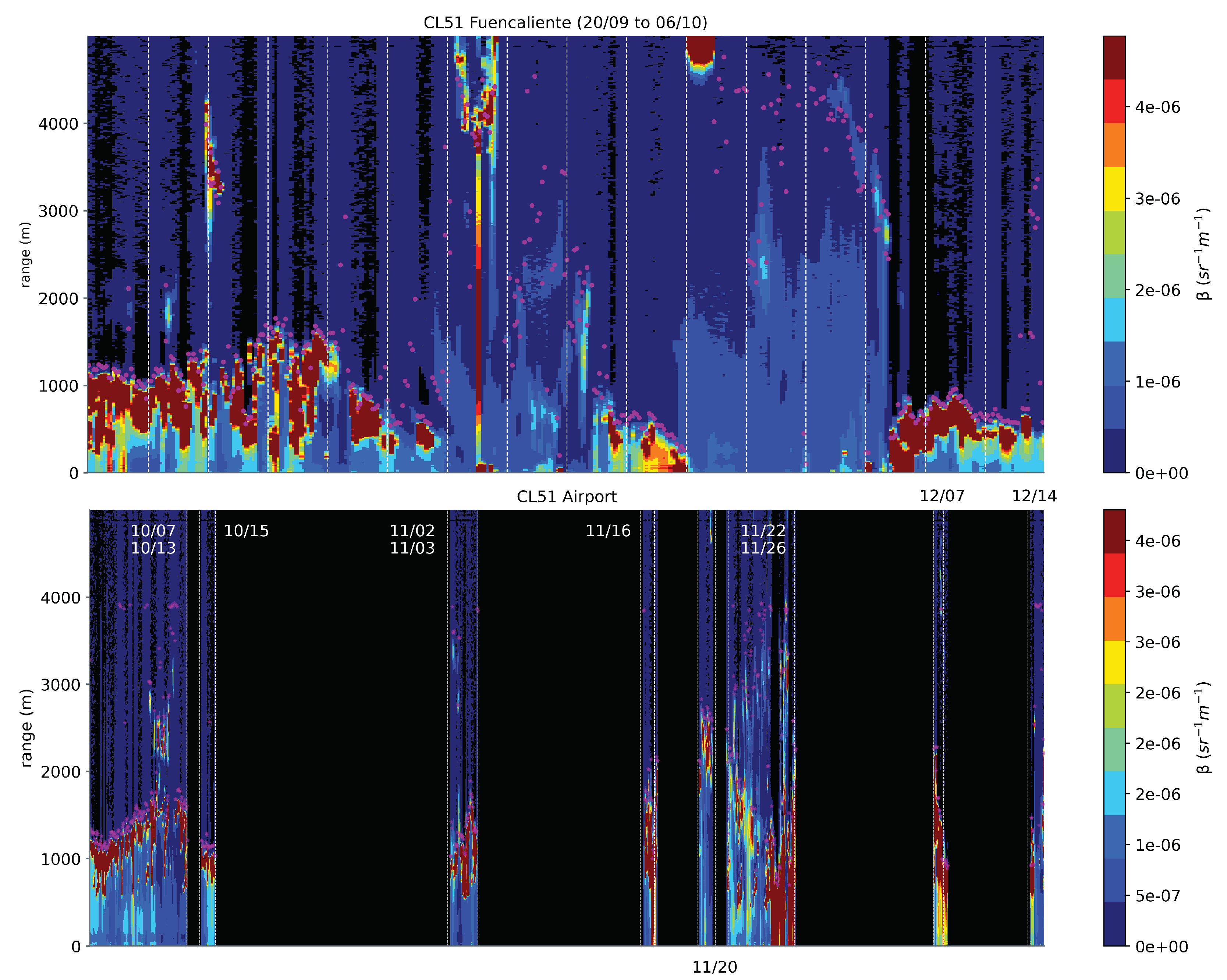
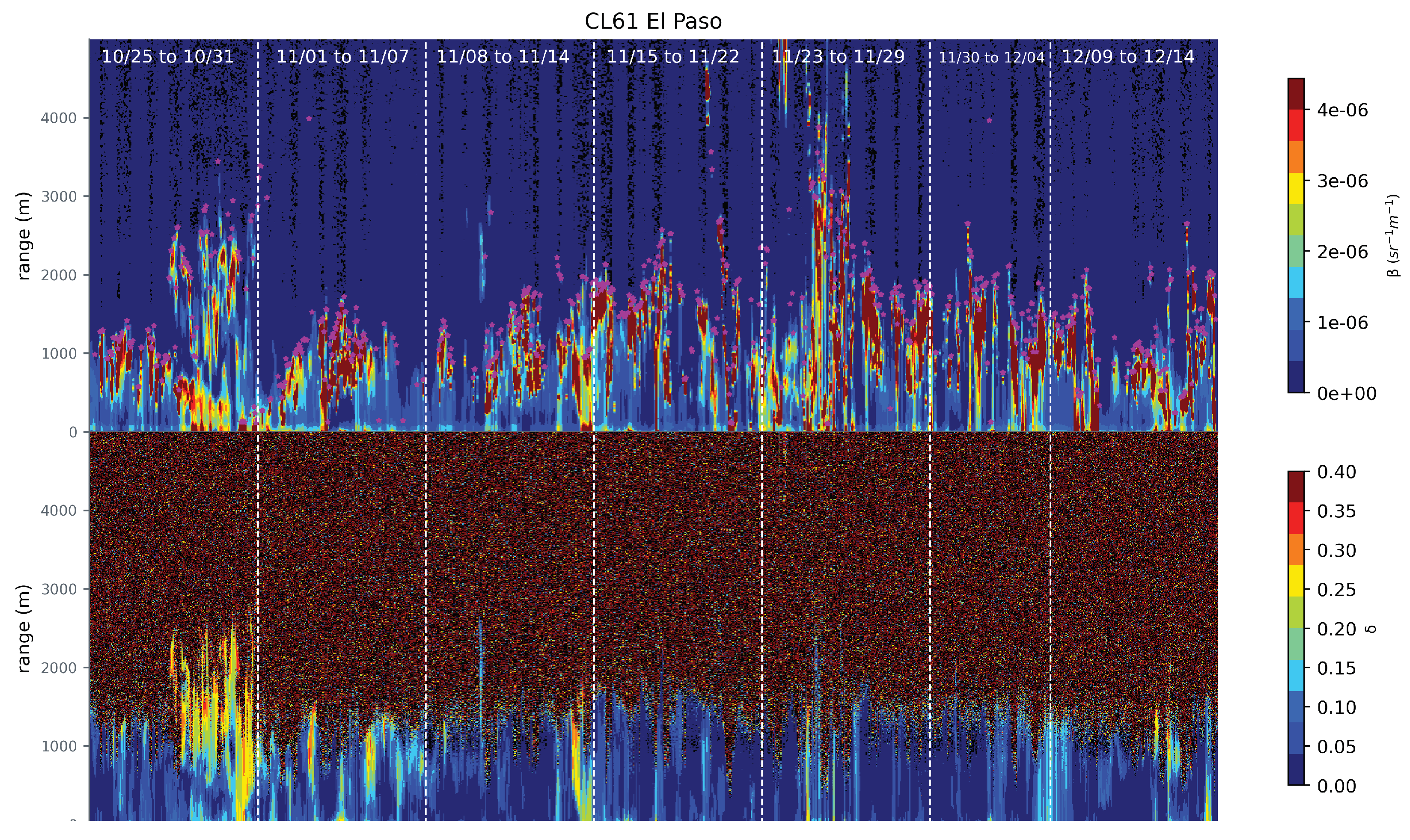
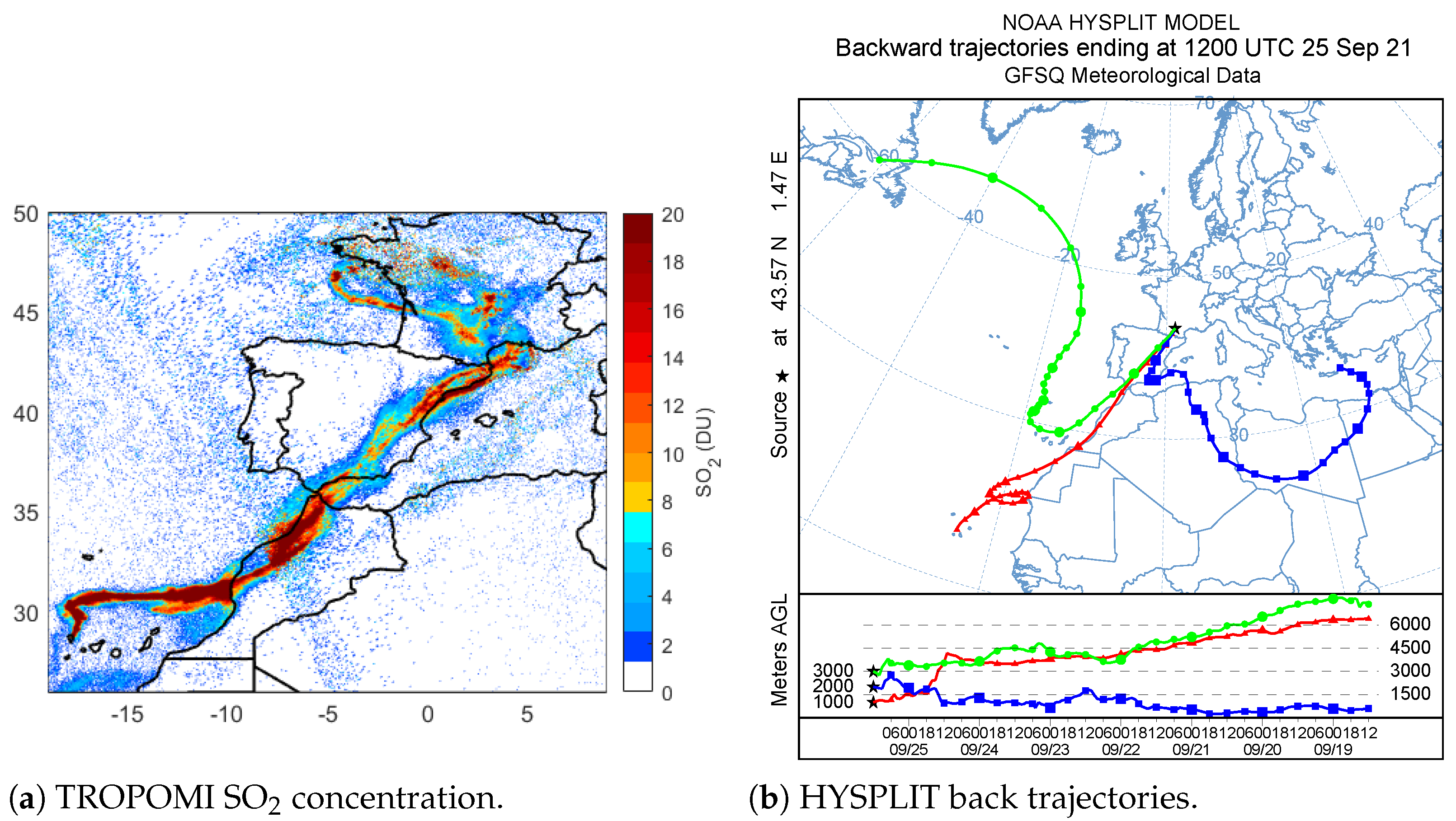
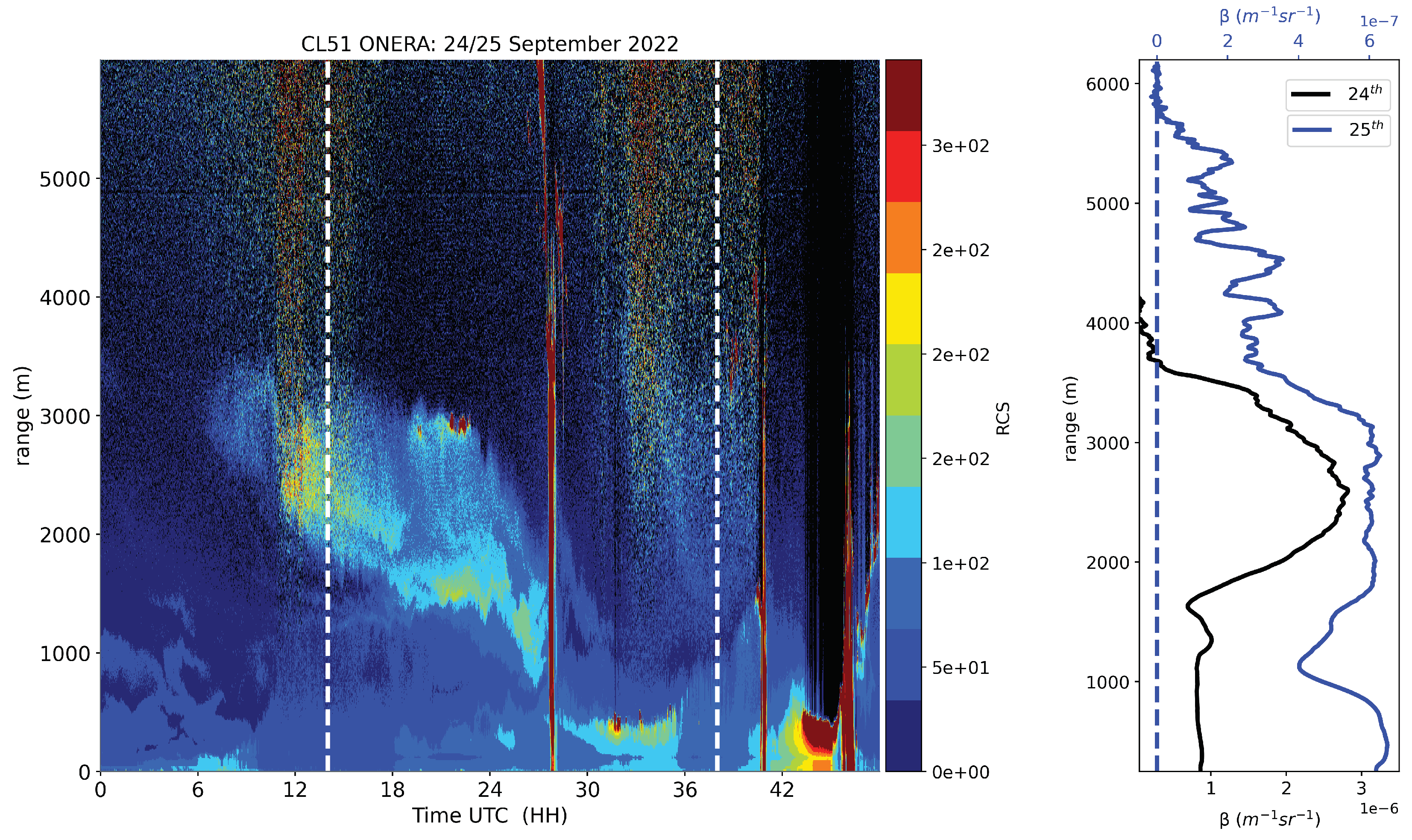
| Radiative Properties | ||||||
|---|---|---|---|---|---|---|
| Station | AOD Fine | AOD Coarse | AOD | LR Coarse | LR Fine | LR |
| RM | 0.03 ± 0.02 | 0.18 ± 0.05 | 0.21 ± 0.07 | 21.0 ± 3.8 sr | 3.9 ± 0.8 sr | 24.9 ± 4.1 sr |
| LP | 0.03 ± 0.02 | 0.23 ± 0.06 | 0.26 ± 0.07 | 30.1 ± 10.3 sr | 6.9 ± 1.8 sr | 41.1 ± 10.6 sr |
| (m sr) | ||||
|---|---|---|---|---|
| Station | 0–1 km agl | 1–2 km agl | 2–3 km agl | 3–4 km agl |
| EP | 8 ± 4 × 10 | 7.9 ± 0.2 × 10 | 4 ± 9 × 10 | 5 ± 3 × 10 |
| FC | 9.1 ± 0.3 × 10 | 3 ± 8 × 10 | 9.6 ± 0.1 × 10 | 5 ± 4 × 10 |
| Mass concentration (g m) | ||||
| Station | 0–1 km agl | 1–2 km agl | 2–3 km agl | 3–4 km agl |
| RM-EP fine | 2.6 ± 2.7 | 25.3 ± 2.7 | 12.8 ± 2.7 | 0.2 ± 2.7 |
| RM-EP coarse | 23.9 ± 28.4 | 235.7 ± 28.4 | 119.3 ± 28.4 | 1.49 ± 28.4 |
| LP-EP fine | 3.7 ± 4.7 | 36.0 ± 4.7 | 18.2 ± 4.7 | 0.2 ± 4.7 |
| LP-EP coarse | 27.6 ± 44.3 | 272.3 ± 44.3 | 137.9 ± 44.3 | 1.7 ± 44.3 |
| LP-FC fine | 41.5 ± 4.7 | 13.7 ± 4.7 | 0.4 ± 4.7 | 0.2 ± 4.7 |
| LP-FC coarse | 313.7 ± 44.3 | 103.4 ± 44.3 | 3.3 ± 44.3 | 1.0 ± 44.3 |
Publisher’s Note: MDPI stays neutral with regard to jurisdictional claims in published maps and institutional affiliations. |
© 2022 by the authors. Licensee MDPI, Basel, Switzerland. This article is an open access article distributed under the terms and conditions of the Creative Commons Attribution (CC BY) license (https://creativecommons.org/licenses/by/4.0/).
Share and Cite
Bedoya-Velásquez, A.E.; Hoyos-Restrepo, M.; Barreto, A.; García, R.D.; Romero-Campos, P.M.; García, O.; Ramos, R.; Roininen, R.; Toledano, C.; Sicard, M.; et al. Estimation of the Mass Concentration of Volcanic Ash Using Ceilometers: Study of Fresh and Transported Plumes from La Palma Volcano. Remote Sens. 2022, 14, 5680. https://doi.org/10.3390/rs14225680
Bedoya-Velásquez AE, Hoyos-Restrepo M, Barreto A, García RD, Romero-Campos PM, García O, Ramos R, Roininen R, Toledano C, Sicard M, et al. Estimation of the Mass Concentration of Volcanic Ash Using Ceilometers: Study of Fresh and Transported Plumes from La Palma Volcano. Remote Sensing. 2022; 14(22):5680. https://doi.org/10.3390/rs14225680
Chicago/Turabian StyleBedoya-Velásquez, Andres E., Manuela Hoyos-Restrepo, Africa Barreto, Rosa D. García, Pedro Miguel Romero-Campos, Omaira García, Ramón Ramos, Reijo Roininen, Carlos Toledano, Michaël Sicard, and et al. 2022. "Estimation of the Mass Concentration of Volcanic Ash Using Ceilometers: Study of Fresh and Transported Plumes from La Palma Volcano" Remote Sensing 14, no. 22: 5680. https://doi.org/10.3390/rs14225680
APA StyleBedoya-Velásquez, A. E., Hoyos-Restrepo, M., Barreto, A., García, R. D., Romero-Campos, P. M., García, O., Ramos, R., Roininen, R., Toledano, C., Sicard, M., & Ceolato, R. (2022). Estimation of the Mass Concentration of Volcanic Ash Using Ceilometers: Study of Fresh and Transported Plumes from La Palma Volcano. Remote Sensing, 14(22), 5680. https://doi.org/10.3390/rs14225680








